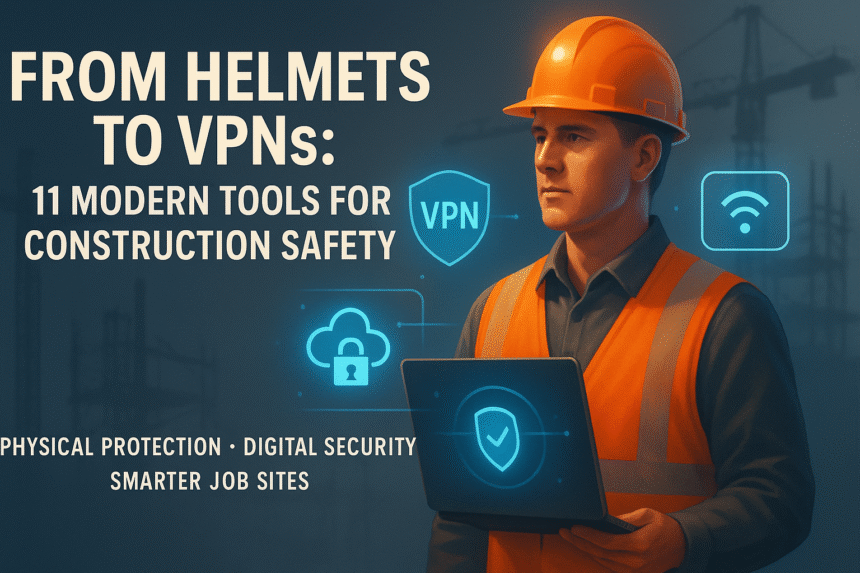John tightened his helmet and glanced at the site monitor—but it wasn’t falling debris that worried him. It was the network login flashing red.
- Traditional Tools That Still Matter
- Hybrid Tools Bridging Old and New
- Digital Tools Transforming Site Safety
- Conclusion
- FAQ: Common Questions About Modern Construction Safety Tools
- 1. Do I really need digital tools if my site already uses traditional safety gear?
- 2. Is using a VPN overkill for a small or medium-sized construction business?
- 3. What kind of passwords should construction crews be using?
- 4. How much does it cost to modernize a jobsite with these safety tools?
- 5. Are there any regulations or laws that require digital safety tools?
Construction safety in 2025 isn’t just about steel-toe boots and hard hats anymore. With connected cameras, smart sensors, and cloud-based access tools, the jobsite now extends into cyberspace—and so do the risks.
In this guide, we’ll walk you through 11 modern tools every construction professional needs—from traditional protective gear to digital defenses like a VPN and password generator. Whether you’re leading a large crew or managing a small team, staying safe now means securing both people and data.
Traditional Tools That Still Matter
These tools aren’t going anywhere. While newer gadgets dominate the headlines, these essentials remain the backbone of jobsite safety in 2025—if you choose them wisely.
1. Hard Hats
Why it matters:
Head injuries are still among the most serious incidents on any jobsite. Even in low-risk zones, falling tools or debris can cause life-altering trauma.
What to look for:
- Type I or Type II classification (top-only vs. top & side impact protection)
- Compliance with ANSI Z89.1 (U.S.) or EN 397 (EU) standards
- Comfort features like ratchet-adjustable suspension, sweatbands, and ventilation slots
Modern upgrade:
Smart helmets now come with impact sensors and fatigue alerts. These can feed into cloud dashboards for safety audits and compliance.
Common mistake:
Using expired or UV-damaged hard hats—or ones plastered in stickers that compromise shell integrity.
2. Steel-Toe Boots
Use case:
Protect against crushed toes, nail punctures, and slippery surfaces. It’s not just about foot safety—it’s about mobility and avoiding long-term injuries.
Selection tips:
- Steel toe or composite toe (lighter, non-conductive)
- Slip-resistant soles, puncture-proof midsoles, and ankle support
- Moisture-wicking insoles for long shifts
Upgrade idea:
Look for boots with metatarsal protection or EH-rated insulation if working around live circuits.
Top brands (U.S./U.K. market):
Timberland PRO, Red Wing, CAT, Wolverine
Pro tip:
Inspect soles every 6 months—worn tread significantly increases fall risk.
3. Safety Goggles
Why they matter:
Eye injuries are often irreversible. From grinding dust to chemical splashes, your eyes are constantly at risk.
What to choose:
- Anti-fog and anti-scratch coatings
- Wraparound design with side shields
- UV400 protection for outdoor work
Don’t do this:
Never substitute regular sunglasses—they won’t shield against projectiles or fumes.
4. High-Visibility Vests
Key function:
Keeps workers visible to moving vehicles, cranes, and equipment—especially in low-light or high-traffic conditions.
Best practices:
- Opt for ANSI/ISEA Class 2 or 3 certified vests
- Choose LED-integrated or reflective-stripe designs for nighttime or tunnel work
- Pockets, badge holders, and breathable mesh improve functionality
Pricing range:
Basic vests: $5–10
Premium multi-use vests: $25–35
Hybrid Tools Bridging Old and New
These tools blend traditional jobsite wisdom with modern intelligence—providing better insight and real-time alerts without requiring a full tech overhaul.
5. Smart Wearables
What they are:
- Fatigue-monitoring caps that detect microsleeps
- Vibration-sensing gloves to prevent overexposure to tool stress
- Fall-detection harnesses that auto-alert supervisors
Why it matters:
These tools flag danger before an accident happens—protecting lives and minimizing lost-time incidents.
Real-world example:
SmartCap’s fatigue monitoring system helped reduce micro-naps among heavy machinery operators by 30% in one Queensland project.
Buyer tip:
Comfort matters—if it’s bulky or annoying, your team won’t wear it. Look for ergonomic designs and rugged battery life.
6. Surveillance Cameras with Cloud Backup
Not just for theft prevention:
Modern jobsite cameras now include:
- Motion-activated recording
- AI detection (e.g., identifying workers without hard hats)
- Cloud-based footage that’s searchable and sharable
Installation advice:
- Choose IP66+ weatherproof, infrared night vision, and 360° coverage
- Integrate with remote access platforms—but use a VPN to secure login endpoints
Best brands for jobsite use:
Reolink, Hikvision (U.S.), Dahua, Arlo Pro
Security risk alert:
Many construction firms leave default admin passwords unchanged—a massive vulnerability for cloud surveillance systems.
Digital Tools Transforming Site Safety
These tools are invisible, yet vital. They’re designed to protect not just the physical workspace, but the digital infrastructure behind modern construction operations.
7. VPN (Virtual Private Network)
Why it’s essential:
From remote camera systems to mobile jobsite apps, everything connects online. Without a VPN, that traffic is exposed to hackers, phishing, or industrial espionage.
How it protects you:
- Encrypts all jobsite internet traffic
- Prevents third parties from intercepting camera feeds, cloud blueprints, or payroll data
- Reduces risk of ransomware attacks targeting SMBs
Deployment tips:
- Choose VPNs with kill switch, 256-bit encryption, multi-device support
- Consider router-level VPNs for site-wide coverage
Top options for contractors:
- X-VPN: Simple deployment, business plans, kill switch
- NordLayer, Perimeter 81: Built for remote team security
Bonus:
VPNs also help teams work securely from hotels, cafes, or mobile offices.
8. Password Generator for Access Control
Common problem:
“SiteAdmin123” is still the most common jobsite login. Reused, predictable passwords are ticking time bombs.
Solution:
Use a password generator and manager to:
- Create complex, random passwords per platform
- Assign role-based access to sign-in systems, cameras, or compliance software
- Instantly revoke credentials when workers leave
Recommended tools:
1Password Business, Bitwarden, Dashlane Teams
Practical tip:
Enable 2FA (two-factor authentication) for all project-critical accounts.
9. Digital Sign-In Systems
Why replace paper logs?
- Accurate headcounts during emergencies
- Built-in health screening
- Instant report exports for audits and compliance checks
Features to look for:
- GPS or geofence check-in
- Facial recognition
- Worker qualification verification
Best-in-class apps:
CrewSight, SignOnSite, eSub
Price range:
$20–$50/month per site, depending on features
10. Drone Monitoring and Inspection
Value add:
- Perform dangerous or hard-to-reach inspections without putting workers at risk
- Thermal imaging for detecting overheating panels or structural anomalies
Compliance tip:
In the U.S., all commercial drone pilots need FAA Part 107 certification
Smart use case:
Daily drone sweeps can detect safety hazards—like unguarded scaffolding—before crew arrival.
11. Safety Training Apps & Dashboards
Why they matter:
Onboarding delays, expired certifications, and untrained workers are silent liabilities.
Use case examples:
- Assign toolbox talks before a shift
- Track licenses and certifications
- Export weekly safety summaries to stakeholders
Top tools:
iAuditor, SafetyCulture, SkillSignal
Must-have features:
- Offline mode
- Multilingual UI for diverse crews
- Supervisor dashboards with task assignments and alerts
Conclusion
Construction safety has evolved—from helmets to VPNs, from heavy boots to lightweight wearables. In 2025, safety is no longer just physical. It’s procedural, data-driven, and digitally enforced.
Whether you’re managing a multimillion-dollar build or running a three-person crew, embracing both traditional and modern safety tools is the key to a secure, compliant, and future-ready site.
FAQ: Common Questions About Modern Construction Safety Tools
1. Do I really need digital tools if my site already uses traditional safety gear?
Yes. Traditional gear protects the body, but digital tools protect your data, workflows, and reputation. Cloud-connected tools like surveillance systems, VPNs, and digital sign-in apps help you:
- Stay compliant with regulations (e.g., OSHA recordkeeping)
- Prevent delays from cyberattacks or lost inspection data
- Respond faster during incidents with real-time alerts
Modern jobsite risks are both physical and digital—your protection strategy should reflect that.
2. Is using a VPN overkill for a small or medium-sized construction business?
Not at all. In fact, small businesses are often the most vulnerable to cyber threats due to weaker IT infrastructure.
Using a VPN ensures:
- Your remote camera feeds and safety dashboards aren’t intercepted
- Confidential client data and blueprints stay encrypted
- Devices on public Wi-Fi (e.g., field tablets or mobile hotspots) are protected
Even a simple, low-cost VPN like X-VPN can significantly reduce your exposure to attacks.
3. What kind of passwords should construction crews be using?
Strong, unique passwords are non-negotiable for access to:
- Sign-in systems
- Camera portals
- Project management apps
Best practice:
- Use a password generator to create 16+ character randomized strings
- Store them in a secure password manager (like 1Password or Bitwarden)
- Enable 2FA (Two-Factor Authentication) wherever possible
Avoid sharing generic team logins—assign role-based access and revoke it when workers leave.
4. How much does it cost to modernize a jobsite with these safety tools?
You don’t need to overhaul everything at once. Here’s a rough breakdown:
| Tool | Estimated Monthly Cost |
| VPN (team license) | $10–$30/user |
| Password manager | $4–$8/user |
| Smart helmets/wearables | $100–$300/unit (one-time) |
| Digital sign-in system | $20–$50/site |
| Surveillance with cloud backup | $200–$500 initial + $10/month cloud |
| Training apps | $5–$20/user/month |
Start with your most vulnerable areas—e.g., unsecured data or weak training—and scale up from there.
5. Are there any regulations or laws that require digital safety tools?
While OSHA and similar authorities primarily focus on physical protections, many compliance requirements now assume accurate digital records, such as:
- Time logs
- Training certificates
- Inspection documentation
Failing to keep auditable records (e.g., using paper logs) can result in fines, delays, or failed audits.
Digital tools don’t just help you stay safer—they help you prove it.















